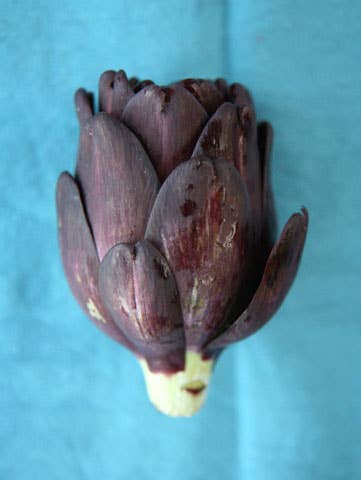
Nine Artichoke Varieties
Scores of different artichoke cultivars—encompassing a wide range of sizes, shapes, and colors—are available outside the United States. Here, by contrast, a single variety has dominated the market since the 1920s: the big, round California green globe. But in recent years California growers like Steve Jordan of Baroda Farms, in the town of Lompoc, have started to change that. Since 1986, Jordan has been developing domestic cultivars based on artichoke varieties commonly found in Italy and France. Some of the varieties Jordan grows work well as annuals, which are planted anew from seed each year and are not subject to the rigid spring-fall harvest cycle that governs perennials like the classic green globe, which comes from a single plant that is cultivated year after year. All nine specimens described here—some perennials, some grown from seed—came from Baroda Farms.
1. Light red and only roughly one inch in diameter when fully grown, the purple baby anzio is a relative of the romanesco artichoke of the Lazio region of Italy. Like many baby artichokes, baby anzios can be cooked and eaten whole.
2. Developed in the mid-1980s by a California grower named Rusty Jordan, the big heart is aptly named. It is endowed with a large, fleshy base and weighs in at over a pound. This green, 3 1⁄2-5 1⁄2" giant—the first patented annual artichoke grown from seed—is excellent for stuffing.
3. The classic green globe, sometimes called just the globe, has a buttery-tasting heart and bottom and an ample amount of meat at the base of the petals. This artichoke, which ranges in size from three to five inches in diameter and was traditionally cultivated as a perennial, was originally brought to California from Italy but is similar in shape and flavor to the French camus de bretagne, a summer choke grown in Brittany.
4. The oblong siena, about four inches in diameter and born of a breeding program in central Italy, has a small choke and a wine red color. Slow to mature and still grown in relatively small quantities, this small artichoke usually weighs less than a pound and has a heart tender enough to be eaten raw.
5. The petite mercury, with its red-violet hue and distinctive rounded top, is sweeter than many other artichokes and is usually three and a half inches in diameter. Like the baby anzio, the mercury is derived from the Italian romanesco.
6. The dense and rotund omaha artichoke (up to six inches wide) owes its striking appearance to its sharply tapered red-and-green leaves. The omaha is less bitter than many artichoke varieties.
7. The two-inch-wide fiesole artichoke has a fruity flavor and a deep wine color that does not fade with cooking. Bred from the violetta de provence, a purple variety native to southern France, the fiesole has a comparatively tender stalk that can be quickly steamed and eaten.
8. The chianti, a classically shaped, four-inch-wide green artichoke with a touch of maroon on the leaves, also (like the mercury) traces its lineage to the iconic Italian romanesco.
9. The blocky and vividly colored** king** has distinctive green spots at the tips of its leaves. Usually four inches in diameter and bred from romanesco varieties mixed with other Italian artichoke strains, the king typically weighs more than a pound in peak season.
Keep Reading
Continue to Next Story










